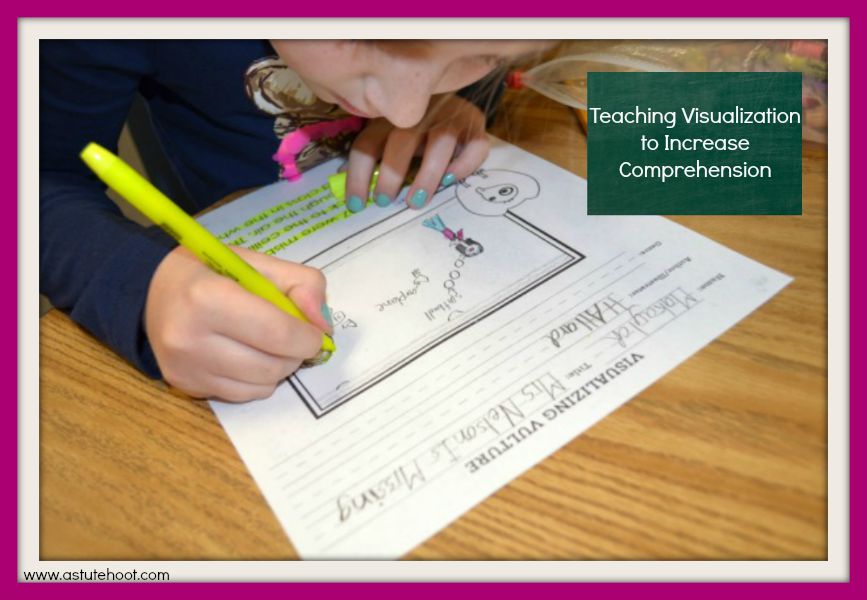“I’m Vern the Visualizing Vulture; use me like a TV.
Events, characters, and settings are what I help you see.
If you picture these in your mind like your favorite movie,
Then understanding what you read will be so groovy!”
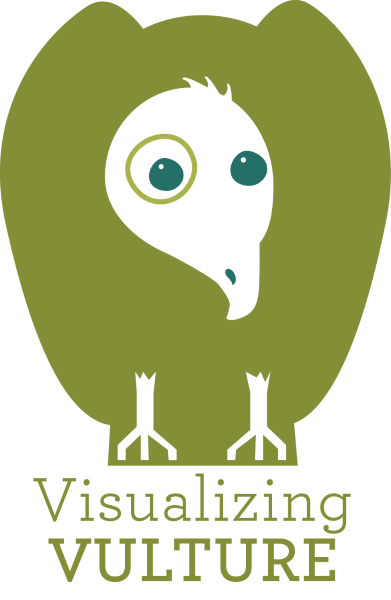
Vern the Visualizing Vulture is one our comprehension strategy animals in Hazel’s Reading Roost. Vern supports students in visualizing what they read. Read more about Vern’s strategy below…
WHAT is visualizing? Efficient readers use all 5 senses to visualize or create images in their mind as they read. These images help readers draw conclusions, make predictions, interpret information and assist with overall comprehension.
WHY is visualizing important? Visualizing helps students develop a thorough understanding of the text as they consciously use words to create mental images. Visualizing also creates personal connections between the readers and text; readers who can picture events or characters are more actively engaged and invested in their reading.
HOW do I teach visualizing? Direct modeling of the active thought process is the first step in teaching the visualization strategy. Begin with an engaging passage with several examples of descriptive language appropriate for students’ listening level.
Watch this video to see how to teach visualizing in three easy steps:
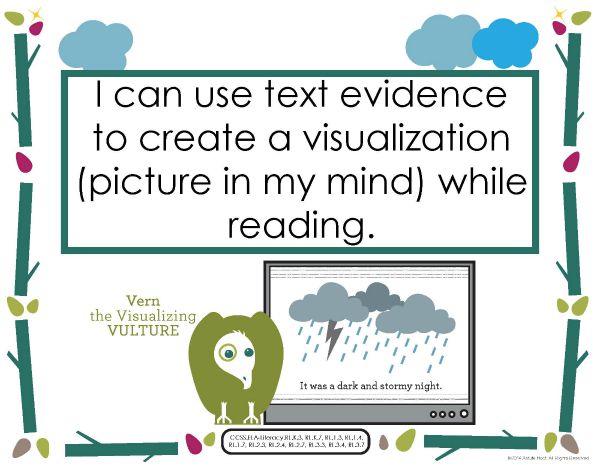
Introduce Vern and read accompanying poem. Then tell students to close their eyes and listen carefully to the passage being read aloud and ask them to see if they can imagine the scene the words describe. Tell them to pretend they are making a movie—what would they see behind the camera?
Read the passage aloud. After reading passage, share your visualization with a detailed think-aloud as you draw it for students. Be as specific as possible with your think-aloud, citing specific descriptive words and phrases from the text. Make connections and predictions as you share your visualization. Use this sentence frame to structure the think-aloud:
| While reading, I visualized ______________________________________________ In my brain I can see ___________________________________________________ The author showed me _________________________________________________ I can taste/smell/feel/hear _____________________________________________ |
After you model, allow students to try the visualization strategy. Record a descriptive paragraph on the Visualization Reproducible and read aloud while students close their eyes and visualize. Remind students to stay alert and listen for what the characters smell, taste, feel, hear and think. After reading aloud, prompt students to draw their visualizations. Allow students to put up privacy folders while they are drawing so they aren’t tempted to look at others’ visualizations for inspiration.
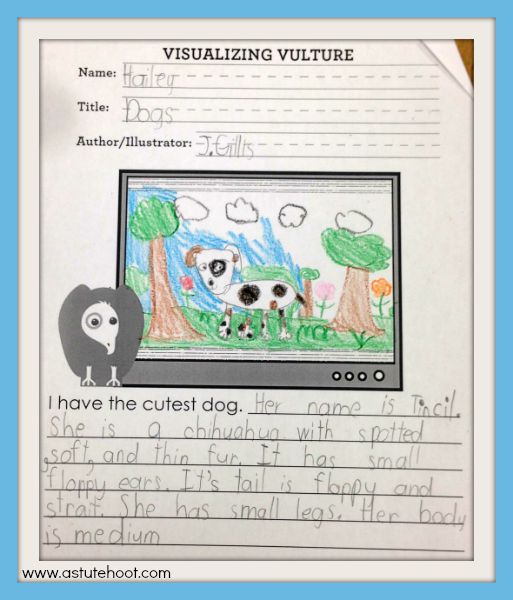
After everyone is done, have students put down their privacy folders and take a Visualization Venture, a silent walk around the room while students study each others’ visualizations. Provide time to Think-Pair-Share to discuss similarities, differences and any other observations. Emphasize that everyone’s visualizations will differ somewhat because everyone has different background knowledge and experiences, but there should be some common elements based on evidence from the text.
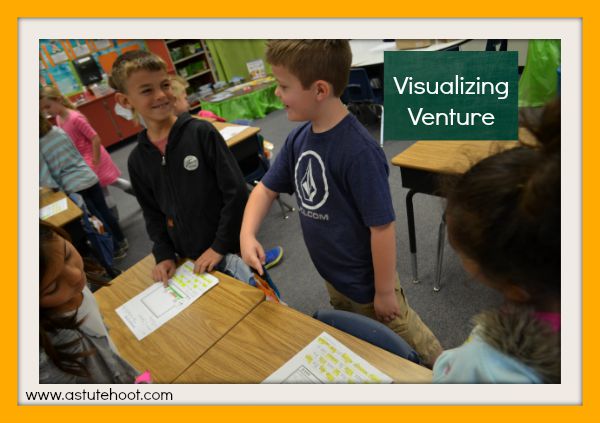
If students create images that do not fit the words, help them question their image and adjust. If students are having difficulty, try another short read-aloud section.
As students grasp the visualization strategy, incorporate into daily reading activities through drawings and mental imagery. Be sure to use not only physical images but also characters’ feelings and ideas. Visualization teaches students to become active readers and critical thinkers.
The Visualizing Vulture Reproducible has 2 options to allow for differentiation:
- You can write the descriptive paragraph or passage on the lines below Vern’s TV and make copies for class. Students will read this paragraph and highlight key words and phrases that helped them create visualization. Instruct students to draw their visualization inside Vern’s TV. This is ideal for introducing the visualization strategy.
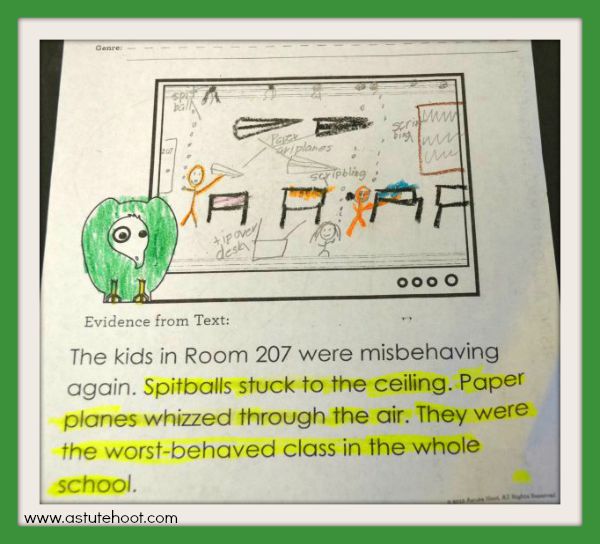
- As students become more proficient with the visualization strategy, prompt them to record the evidence used to create the visual, citing directly from the text.
WHEN should I use visualizing? Explicit reading strategy instruction should be included in a balanced literacy program. Vern the Visualizing Vulture can be incorporated into various components of literacy lessons. Here are some specific examples of when to use Vern:
- Guided Reading: Review the strategy by reading the Vern Visualizing Poem. Read a selected passage from your guided reading text. Model recording your visualizations on the Visualizing Reproducible. As you describe your visualization to students, be sure to incorporate textual evidence and make personal connections. Distribute Visualizing Vulture Reproducibles and copies of the guided reading text in which you have pre-selected passages. Any illustration should be covered with Post-Its. Prompt students to read and create visualization, recording in Visualizing Vulture Reproducible. After students are finished, discuss visualizations and encourage them to refer to the textual evidence used in the visualization.
- Visualizing Vulture Center: Create a portable reading center: Place Visualizing Vulture Reproducibles and a book or text at students’ reading level in a large manila envelope with a copy of the Vern the Visualizing Vulture Poem glued onto the front. Instruct students that during center time they are to take an envelope to their desks and use the Visualizing Vulture Reproducible to record a visualization created while reading the text.
- Reading Response Journal: Use the Reading Response Journals to make independent reading accountable in school and at home. Instruct students to log independent reading information and respond to the text using one or more of comprehension strategy animal prompts.
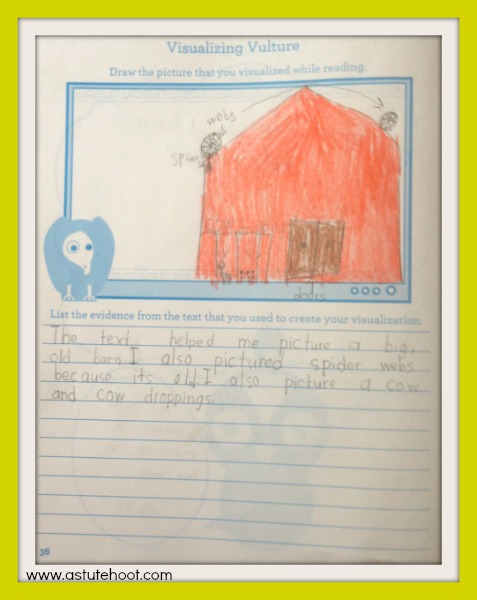
To reinforce the predicting strategy, encourage students to use Vern the Visualizing Vulture’s sentence stems in their responses.
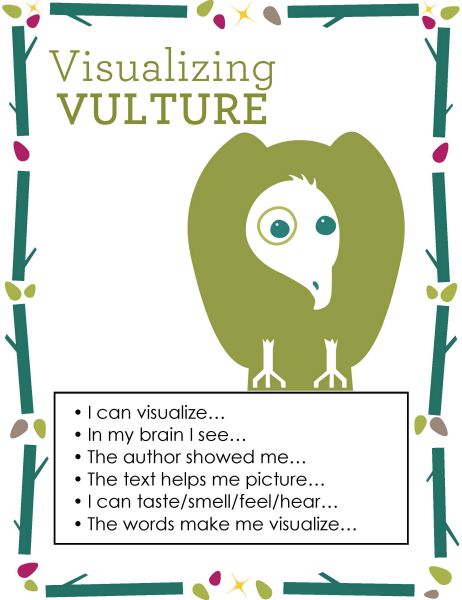
Helpful Hints:
- Create Reading Response Journal. Print the Reading Response Journals to create individual journals for each student. Print cover page on cardstock and laminate. Use a blank piece of laminated cardstock for the back cover. Print several copies of the Reading Response Log page and staple or bind together to form a journal. These journals can be used in class during independent reading time or sent home to record reading time for homework. The Reading Response Journal sets a purpose for independent reading and promotes student ownership and accountability. Journal responses allow teachers and parents to easily assess understanding and engagement.
- Purchase Quality Reading Response Journals. Use these Astute Hoot Reading Comprehension Journals from Really Good Stuff to practice the questioning strategy along with other comprehension strategies. Hazel and friends guide students through a variety of comprehension strategies in this helpful journal that can be used with authentic literature or basal readers.

- Display Visualizing Vulture Anchor Chart. Print and post Visualizing Vulture Anchor Chart located in the unit. Display near your guided reading center for easy reference. Encourage students to use the sentence stems during discussions and in their written responses.
Vern’s unit is perfect for general education, special education, RTI and reading intervention. Download the complete unit here.


